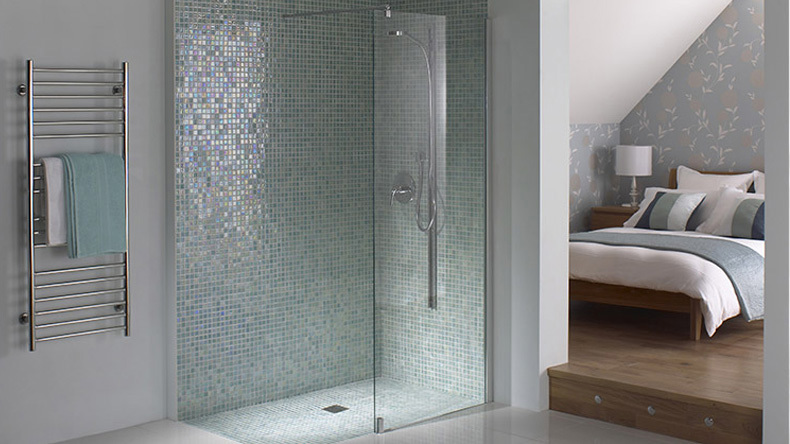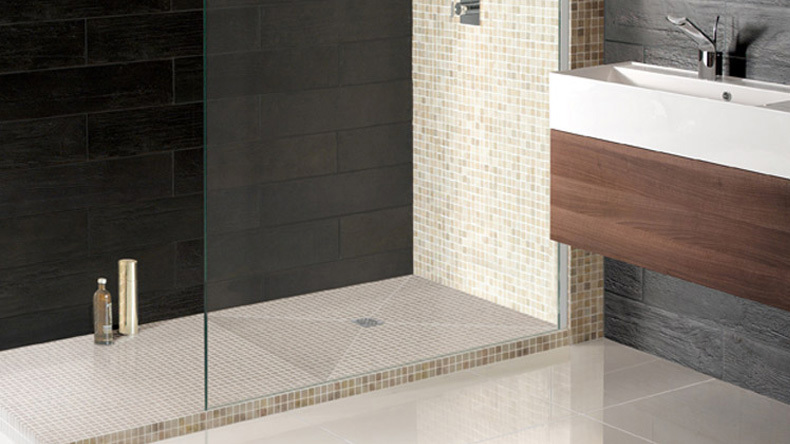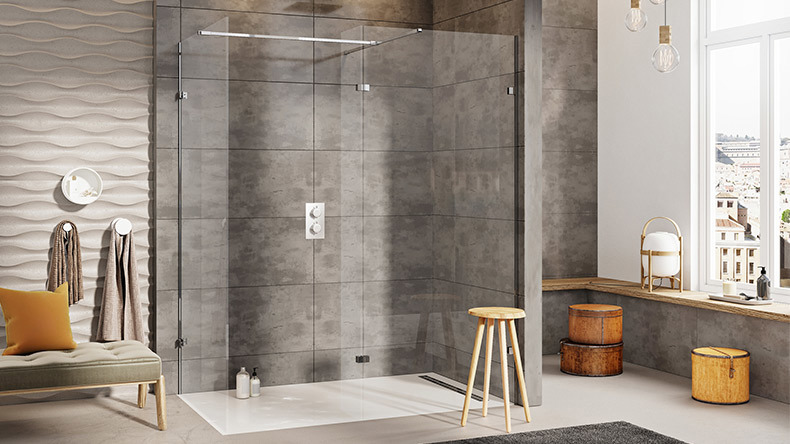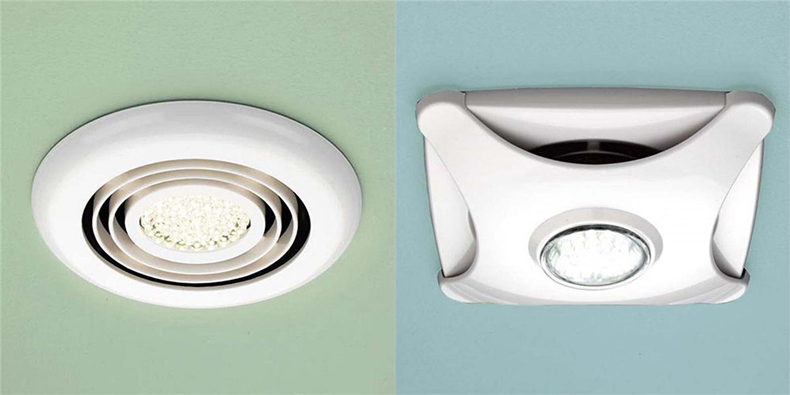Unless you have the luxury of time on your hands, the chances are most days you opt for the convenience of a shower over the indulgence of a bath.
Our busy lives dictate our cleaning routines, and in recent years we have seen a steady increase in people looking to create a beautiful and practical wet room rather than the more conventional bath-based bathroom.
But not every home is well-suited to the wet room revolution. If you have one main family bathroom, replacing it with a wet room is unlikely to do your house value any particular favours. After all, children can’t float rubber ducks on a tanked and tiled floor. Wet rooms are particularly well suited to en-suite bathrooms, modern flats, or as a safe showering environment for the disabled or any person who has mobility difficulties.
What Is A Wet Room?
A wet room is simply a room with a tiled floor that has been waterproofed (‘tanked’) instead of a conventional shower tray. If the entire room has been tanked there is no need for any glass screens or shower doors, and the room itself becomes the shower enclosure, with a shower drain inset into a gently sloped floor. If you’d rather, you can create a showering area by installing glass panels.
A slightly cheaper option would then be to tank only the part of the room that has been divided off with glass panels, plus a bit extra to ensure the area is water-tight.

.
Can Anyone Have a Wet Room?
Theoretically, anyone can have a wet room installed in their house. Provided you purchase good quality materials and employ an experienced installer, there’s nothing too complicated to worry about. If you have a solid concrete floor you won’t be able to sink the waste under the floor which makes installing a level access wet room floor a bit tricky. One workaround is to create a showering area that is a few inches taller than the rest of the floor and sectioned off with screens.

Why Would You Want a Wet Room?
There are many advantages to having a wet room in your home. From a purely aesthetic point-of-view, a wet room is in naturally stylish and brings the wow-factor to your room. There's something liberating about showering in a wet room, not confined by a tiny enclosure or having to worry about splashing water on the floor.
If you have a relatively small bathroom, wet rooms are a great space-saving solution, given the absence of bulky fittings and fixtures. They can be squeezed into the tiniest of en-suites to create a practical, usable space.
This lack of fixtures and fittings within a wet room also makes cleaning an absolute doddle. Add in wall-mounted toilets and basins and you have a floor completely free from obstacles and clutter. Shower enclosures, with all of their framework and runners are a magnet for dirt and grime, so its refreshing to have nothing to clean other than a single piece of frameless glass, or just the tiled floor.
What Are The Main Benefits of Having a Wet Room?
Safety
Given that wet rooms allow for complete level access to a shower rather than a conventional step up tray, they are perfect for those who are disabled, wheelchair, users or anyone who requires an ‘easy access’ shower solution. On top of this, a showering area floor of mosaic tiles is naturally ‘non-slip’, limiting potential accidents and giving you peace of mind.
Design
Wet rooms are super-stylish by default. Even though there’s nothing particularly new about them, it’s difficult not to be impressed when you walk into a bathroom and see a beautifully tiled floor and walls with no clutter caused by bulky shower enclosures or shiny white trays. Their beauty is in the simplicity and minimalism. They are easy to clean, and great at saving space, making them as practical as they are stylish too. The open plan feel that a wet room creates is something quite liberating and is something quite impressive for any guests you have to stay.

Protection
Generally speaking, wet rooms last significantly longer than conventional bathroom suites. Less appliances, fixtures and fittings means that things are less likely to be broken or leak. To add to this, waterproofing, or tanking, the room protects your building from moisture damage and leaks as well as prolonging the life of your tiles and grouting. Good quality waterproofing products, like the offering from Impey, may not be the cheapest initial option, but with a lifetime guarantee you can be sure that you won’t be worrying about any leaks developing over time. All of this protection is likely to save you both time and money in the long term.
Ease of Installation
The installation of a wet room is not as complicated as many people might presume, but this said it is always best left to the professionals. Some wet room products are easier to install than others, so we would recommend getting in touch and we can discuss the options available and what would be best for you.
Of all the suppliers we deal with, our top recommendation would go to Crosswater. Widely considered one of the UK’s leading wet room specialist manufacturers, they have been producing wet room products since the early 1990s and offer a Lifetime Guarantee. Constantly innovating, they offer product designed to make installation quicker and easier.
Wet rooms can be installed on both concrete and wooden floors as well as being compatible with under floor heating systems, meaning you don’t have to sacrifice toasty toes for the wet room experience. On top of this, a wet room facilitates a shower in a space in which a traditional shower may not have been originally viable.
Value
Wet rooms can add both financial and day-to-day value to your home. As wet rooms require a lot less effort to clean and maintain, you’ll have more time to put your feet up and relax. More importantly, the addition of a wet room as a second bathroom in your household can add some real value to the property when you come to sell.
What Else Do I Need To Consider Before Choosing a Wet Room?
Tanking and Drainage
With all that water spraying willy-nilly around your bathroom, its extra important that you make sure that the room is watertight. If care is not taken to waterproof the room correctly, you risk causing some pretty extensive damage and a hefty repair bill. The most common way to waterproof a wet room is to fit a carefully sealed tanking membrane underneath the floor and wall tiles. There are lots of tanking options to choose from, varying from traditional rolls of bitumen tanking to paint-on waterproofing kits. In some cases, it’s advisable to consider raising the bathroom door threshold by between 5mm and 10mm if the room is very small and/or water is likely to get close to the door.
In terms of wet room drainage, a gradient will need to be created to channel waste water into a drain. A common method of creating a gradient is to install a wet room floor former or install a sub-floor which can then be tiled over and concealed. Such items come with a gradient built-in, so there’s no calculations to be made.
Ventilation
When an entire room is effectively one big shower, extra care should be taken to ventilate the room. If you have a window, it’s best to keep this open as much as possible to prevent the build-up of mould and mildew. You should also fit an extractor fan to remove the moisture from the room whilst you’re showering.
Tiles
When choosing tiles for your wet room floor, it’s always best to choose ones that will be slip resistant. Natural stone or mosaic tiles are the best choice for a wet room floor but be sure to avoid choosing any tiles with a gloss or highly polished finish as they are likely to become slippery when wet and could potentially be dangerous. As with all tiles, there really are no limits to the designs you can achieve. From detailed stone to modular calibrated tiles, you can find anything you need to compliment your wet room vision.
Under floor heating
Although not essential, underfloor heating is definitely something to consider before you go about installing a wet room. If you’re doing all of this work in waterproofing and tiling the floor, it isn’t a great deal of extra work to fit under floor heating in too.
Electric under floor heating systems are a relatively easy installation and provide you with all round toasty toe warmth from the moment you step into the room to the moment you walk out. As a bonus, the added heat from the under floor heating will help dry the room much faster, limiting the potential for mould or unnecessary cleaning.
How Much Does a Wet Room Cost?
Ah, the all-important question. From a materials point of view, whereas a standard shower tray might cost a few hundred pounds of less depending on size, a wet room floor former with all the bits and pieces you need will set you back around £500. The waterproofing will range from under £100 to a couple of hundred pounds depending on the type (membrane, paint-on compound etc.).
Of course the main cost is going to be the installation. It is difficult to put a cost on this as every room will be different, depending on the size, the existing plumbing work and the products chosen. A safe estimate would be anywhere upwards of around £3,000.
It might be easier to think in terms of the EXTRA cost over and above a standard shower installation. We asked a few of our recommended installers and the consensus was a wet room with tanked floor would typically add an extra £300-£500 to an installation, possibly more in certain circumstances.
So there you have it. The extra cost of the items themselves will run to £500 or more for a fit-and-forget wet room, and the cost of installation is likely to start at around £3000, or to put it another way, £500 more than if you forewent the wet room and chose a shower tray instead.
To start shopping, click here for wet room flooring products.








